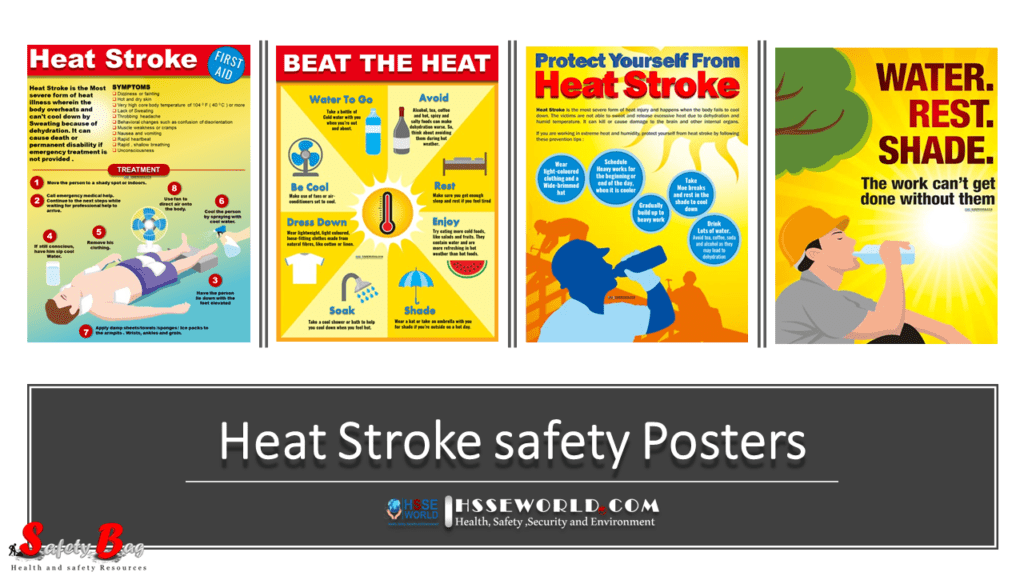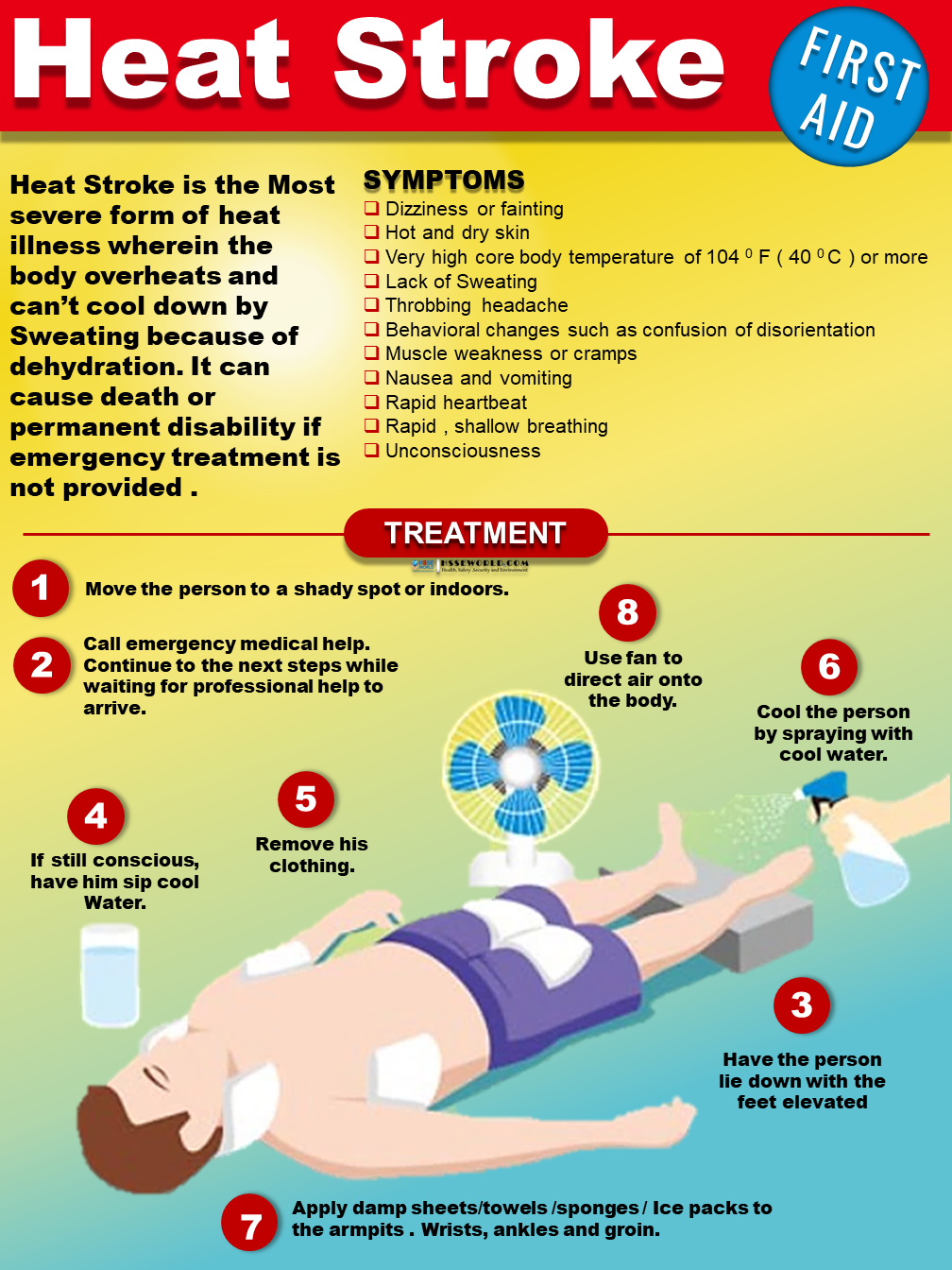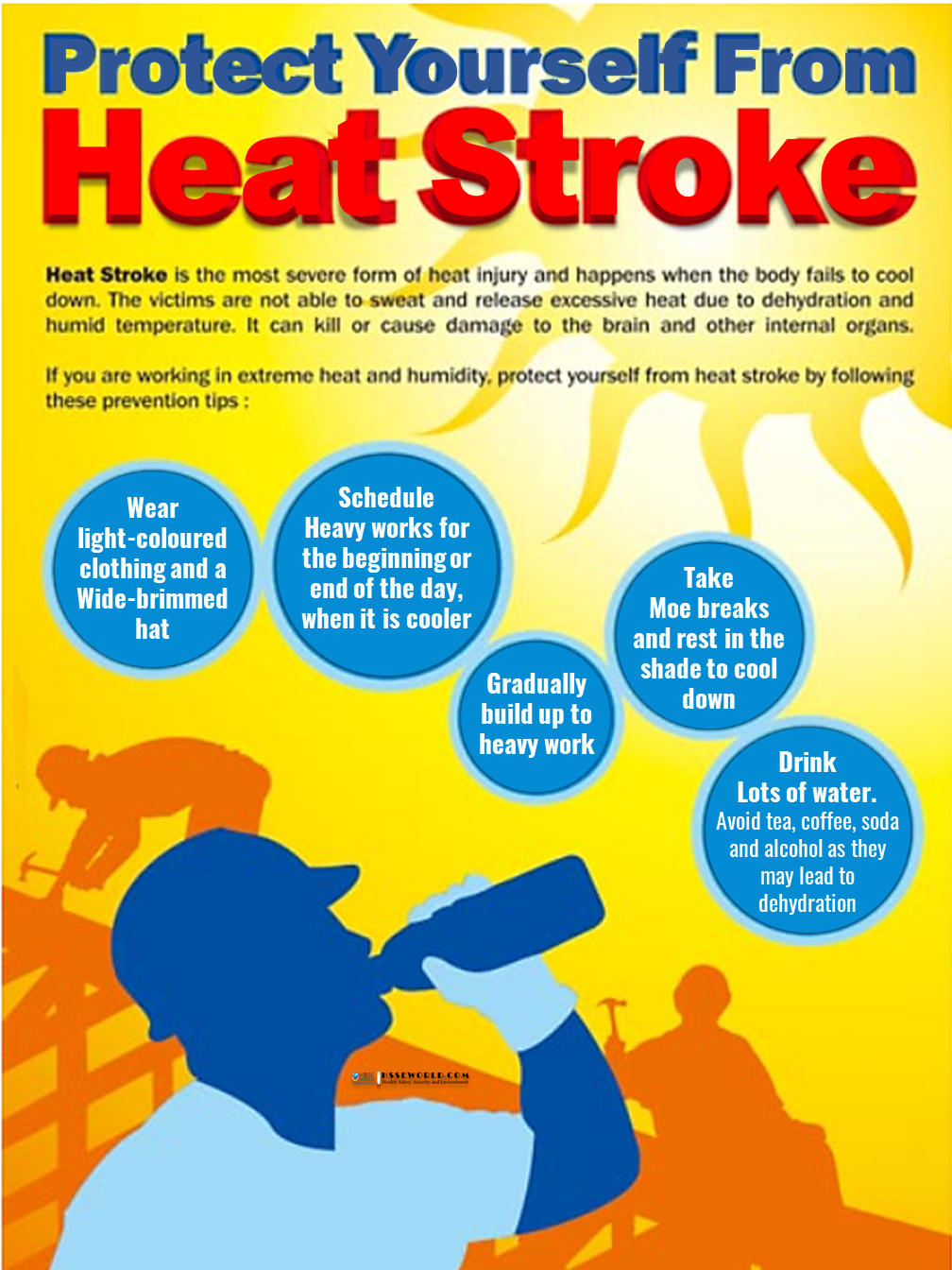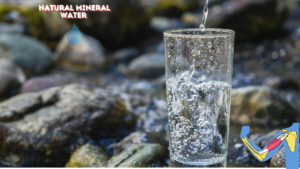Photo of the day: Heat Stroke First Aid and safety posters
Heat stroke is a condition caused by your body overheating, usually as a result of prolonged exposure to or physical exertion in high temperatures. This most serious form of heat injury, heat stroke, can occur if your body temperature rises to 104 F (40 C) or higher. The condition is most common in the summer months. Heat stroke requires emergency treatment. Untreated heatstroke can quickly damage your brain, heart, kidneys, and muscles. The damage worsens the longer treatment is delayed, increasing your risk of serious complications or death.
in the photo of today and the below article you will be able to know more about heat stroke overview, its symptoms, and its treatment in addition Free download of heat stroke safety posters
Also, Read the Heat Stress: Working Safely in the Heat


Symptoms
Heatstroke signs and symptoms include:
- High body temperature. A core body temperature of 104 F (40 C) or higher, obtained with a rectal thermometer, is the main sign of heatstroke.
- Altered mental state or behavior. Confusion, agitation, slurred speech, irritability, delirium, seizures, and coma can all result from heatstroke.
- Alteration in sweating. In heatstroke brought on by hot weather, your skin will feel hot and dry to the touch. However, in heatstroke brought on by strenuous exercise, your skin may feel dry or slightly moist.
- Nausea and vomiting. You may feel sick to your stomach or vomit.
- Flushed skin. Your skin may turn red as your body temperature increases.
- Rapid breathing. Your breathing may become rapid and shallow.
- Racing heart rate. Your pulse may significantly increase because heat stress places a tremendous burden on your heart to help cool your body.
- Headache. Your head may throb.
Also Read: Workplace Summer Safety Hazards: The Top 5
When to see a doctor
If you think a person may be experiencing heat stroke, seek immediate medical help. Call your local emergency services number.
Take immediate action to cool the overheated person while waiting for emergency treatment.
- Get the person into the shade or indoors.
- Remove excess clothing.
- Cool the person with whatever means available — put in a cool tub of water or a cool shower, spray with a garden hose, sponge with cool water, fan while misting with cool water, or place ice packs or cold, wet towels on the person’s head, neck, armpits, and groin.
Causes
Heatstroke can occur as a result of:
- Exposure to a hot environment. In a type of heatstroke, called nonexertional (classic) heat stroke, being in a hot environment leads to a rise in core body temperature. This type of heatstroke typically occurs after exposure to hot, humid weather, especially for prolonged periods. It occurs most often in older adults and in people with chronic illnesses.
- Strenuous activity. Exertional heatstroke is caused by an increase in core body temperature brought on by intense physical activity in hot weather. Anyone exercising or working in hot weather can get exertional heatstroke, but it’s most likely to occur if you’re not used to high temperatures.
In either type of heatstroke, your condition can be brought on by:
- Wearing excess clothing that prevents sweat from evaporating easily and cooling your body
- Drinking alcohol, which can affect your body’s ability to regulate your temperature
- Becoming dehydrated by not drinking enough water to replenish fluids lost through sweating
Risk factors
Anyone can develop heatstroke, but several factors increase your risk:
- Age. Your ability to cope with extreme heat depends on the strength of your central nervous system. At a very young, the central nervous system is not fully developed, and in adults over 65, the central nervous system begins to deteriorate, which makes your body less able to cope with changes in body temperature. Both age groups usually have difficulty remaining hydrated, which also increases the risk.
- Exertion in hot weather. Military training and participating in sports, such as football or long-distance running events, in hot weather are among the situations that can lead to heatstroke.
- Sudden exposure to hot weather. You may be more susceptible to heat-related illness if you’re exposed to a sudden increase in temperatures, such as during an early-summer heat wave or travel to a hotter climate. Limit activity for at least several days to allow yourself to acclimate to the change. However, you may still have an increased risk of heatstroke until you’ve experienced several weeks of higher temperatures.
- A lack of air conditioning. Fans may make you feel better, but during sustained hot weather, air conditioning is the most effective way to cool down and lower humidity.
- Certain medications. Some medications affect your body’s ability to stay hydrated and respond to heat. Be especially careful in hot weather if you take medications that narrow your blood vessels (vasoconstrictors), regulate your blood pressure by blocking adrenaline (beta blockers), rid your body of sodium and water (diuretics), or reduce psychiatric symptoms (antidepressants or antipsychotics). Stimulants for attention-deficit/hyperactivity disorder (ADHD) and illegal stimulants such as amphetamines and cocaine also make you more vulnerable to heatstroke.
- Certain health conditions. Certain chronic illnesses, such as heart or lung disease, might increase your risk of heatstroke. So can being obese, being sedentary, and having a history of previous heatstroke.
Also read: Responding to heat stroke, heat exhaustion
Heatstroke can result in a number of complications, depending on how long the body temperature is high. Severe complications include:
- Vital organ damage. Without a quick response to lower body temperature, heatstroke can cause your brain or other vital organs to swell, possibly resulting in permanent damage.
- Death. Without prompt and adequate treatment, heatstroke can be fatal.
Prevention
Heatstroke is predictable and preventable. Take these steps to prevent heatstroke during hot weather:
- Wear loose-fitting, lightweight clothing. Wearing excess clothing or clothing that fits tightly won’t allow your body to cool properly.
- Protect against sunburn. Sunburn affects your body’s ability to cool itself, so protect yourself outdoors with a wide-brimmed hat and sunglasses and use a broad-spectrum sunscreen with an SPF of at least 15. Apply sunscreen generously, and reapply every two hours — or more often if you’re swimming or sweating.
- Drink plenty of fluids. Staying hydrated will help your body sweat and maintain a normal body temperature.
- Take extra precautions with certain medications. Be on the lookout for heat-related problems if you take medications that can affect your body’s ability to stay hydrated and dissipate heat.
- Never leave anyone in a parked car. This is a common cause of heat-related deaths in children. When parked in the sun, the temperature in your car can rise 20 degrees F (more than 11 C) in 10 minutes. It’s not safe to leave a person in a parked car in warm or hot weather, even if the windows are cracked or the car is in shade. When your car is parked, keep it locked to prevent a child from getting inside.
- Take it easy during the hottest parts of the day. If you can’t avoid strenuous activity in hot weather, drink fluids and rest frequently in a cool spot. Try to schedule exercise or physical labor for cooler parts of the day, such as early morning or evening.
- Get acclimated. Limit time spent working or exercising in heat until you’re conditioned to it. People who are not used to hot weather are especially susceptible to heat-related illness. It can take several weeks for your body to adjust to hot weather.
- Be cautious if you’re at increased risk. If you take medications or have a condition that increases your risk of heat-related problems, avoid the heat and act quickly if you notice symptoms of overheating. If you participate in a strenuous sporting event or activity in hot weather, make sure there are medical services available in case of a heat emergency.
Also download: Safety banners and Posters at construction site
Diagnosis
It’s usually apparent to doctors if you have heat stroke, but laboratory tests can confirm the diagnosis, rule out other causes for your symptoms and assess organ damage. These tests include:
- Rectal temperature to check your core body temperature. A rectal temperature is the most accurate way of determining your core body temperature and is more accurate than mouth or forehead temperatures.
- A blood test to check blood sodium or potassium and the content of gases in your blood to see if there’s been damage to your central nervous system.
- A urine test to check the color of your urine, because it’s usually darker if you have a heart-related condition, and to check your kidney function, which can be affected by heatstroke.
- Muscle function tests to check for serious damage to your muscle tissue (rhabdomyolysis).
- X-rays and other imaging tests to check for damage to your internal organs.
Treatment
Heatstroke treatment centers on cooling your body to a normal temperature to prevent or reduce damage to your brain and vital organs. To do this, your doctor may take these steps:
- Immerse you in cold water. A bath of cold or ice water has been proved to be the most effective way of quickly lowering your core body temperature. The quicker you can receive cold water immersion, the less risk of death and organ damage.
- Use evaporation cooling techniques. If cold water immersion is unavailable, health care workers may try to lower your body temperature using an evaporation method. Cool water is misted on your body while warm air is fanned over you, causing the water to evaporate and cool your skin.
- Pack you with ice and cooling blankets. Another method is to wrap you in a special cooling blanket and apply ice packs to your groin, neck, back, and armpits to lower your temperature.
- Give you medications to stop your shivering. If treatments to lower your body temperature make you shiver, your doctor may give you a muscle relaxant, such as a benzodiazepine. Shivering increases your body temperature, making treatment less effective.
Heat Stroke Posters








Also Read: Photo of the day: Top10 Injuries in office work
Download the Infographic
Now you can download the Infographic ” heat stroke safety Posters” and post them at the workplace to communicate with everyone to be familiar with heat stroke hazards and its symptoms and how to treat it
Also Read: 3 New Ways To Display Signs & Posters
Photo of the day: Heat Stroke First Aid and safety posters. PDF
Download more resources at SAFETY BAG


More photos:
- Photo of the day: 10 Essential Safety Tips for Driving in Hot Weather Conditions
- Photo of the day: best workplace safety tips
- Photo of the day: The Importance of Stop Work Authority in Maintaining Workplace Safety
- Photo of the day: Tomorrow’s Reward for Working Safely Today: Cultivating a Culture of Safety
- Photo of the day: Preventing slips and trips at work
- Photo of the day: Learn the DRSABCD action Plan
- Working with Electricity Electrical Accidents Guide for Electrical Workers
- Photo of the day: Hearing Protection Device Selection
- Photo of the day: If An Earthquake Shakes You-Infographic free
- Fire Safety Posters Free Download
- Photo of the day: First Aid for Electrical Burns-Infographic free
- Infographic: First Aid for Cuts and Scrapes free download
- Photo of The day: Work Safe with Lasers-Laser Safety free
- Photo of the day: Working Safely with chemicals and chemical Management
- Photo of the day: Safe work practices when using MEWPs ( updated)
- Photo of the day: Preventing Common Kitchen Hazards
- Photo of the day: Safe handling of Gas Cylinders and lecture bottles
- Photo of the day: Forklift Stability Triangle
- Photo of the day: Defective Tools Safe Work Practice
- Photo of the day: Lift With Your Legs Not With Your Back
- Photo of the day: First Aid for burns
- Photo of the day: The 7 Principles of HACCP
- Photo of the day: Working Safely with Suspended Loads
- Photo of the day: Heat Stroke First Aid and safety posters
- Photo of the day: Near-Miss Reporting and Posters
- Photo of the day: Ergonomic chair and office chair safety tips
- Photo of the day: Whole Body Vibration
- Photo of the day: Substation Safety Equipment
- Photo of the day: Bypassing Safety Controls Rules
- Photo of the day: Lightning Safety Tips
- Photo of the day: Overhead Power lines Clearance
- Photo of the day: Floor Marking
- Photo of the day: Types of Foot Protection
- Photo of the day: Types of Hand Protection
- Photo of the day: Lockout and Tagout Safety
- Photo of the day: Fall Protection Plans
- Photo of the day: Flood Safety Tips
- Photo of the day: Read All Labels Work safe
- Photo of the day: Run Project safely with Crane Hand Signals
- Photo of the day: Flagman and Traffic control
- Photo of the day: Managing Risks of Exposure to Solvents in the workplace
- Photo of the day: Scissor Lift Safety
- Photo of the day: HSE Bulletin Board
- Photo of the day: Arc-Fault Circuit Interrupters (AFCI)
- Photo of the day: Safe use of ladders and step ladders
- Photo of the day: Concrete Truck Driver Hand Signals
- Photo of the day: Extension Cord Safety Tips
- Photo of the day: Protect your Head
- Photo of the day: choosing the right Anchorage
- Photo of the day: Work-Related Asthma
- Photo of the day: Top FIVE Heavy Equipment Construction Site Safety Tips
- Photo of the day: sun safety in the workplace
- Photo of the day: Cannabis and Impairment in the Workplace
- Photo of the day: Position for safety and comfort-Safety Tips
- Photo of the day: Generator Safety
- Photo of the day: Controlling COVID-19 in the Workplace-Physical Barriers
- Photo of the day: Manual Material handling
- Photo of the day: Personal Protective Equipment last resort
- Photo of the day: WHMIS 2015 – Pictograms
- Photo of the day: Indoor Air Quality
- Photo of the day: Noise in the affected workplace
- Photo of the day: Fatigue at Work
- Photo of the day: Don’t be Driven to Distraction
- Photo of the day: working in heat and Humidex Rating
- How to use Plate Clamps Safely: Safety Moment#34
- Photo of the day: Sitting at work
- Photo of the day: 5 ways to reduce the risk of Slipping and Tripping
- Photo of the day: Preventing the spread of contagious illness
- Photo of the day: Incident Investigations
- Photo of the day: 10 Scaffold Safety Essentials
- Photo of the day: Effective Health and Safety Committees
- Photo of the day: New worker Orientation & Safety Orientation checklist
- Photo of the day: Workplace Inspection
- Photo of the day: musculoskeletal disorders
- Photo of the day: Emergency preparedness in the workplace
- Photo of the day: Mental health in the workplace
- Photo of the day: Trenching Safety Tips That Can Save a Life
- Photo of the day: Dangerous Goods Classes
- Photo of the day: Safety Equipment for Confined Spaces
- Photo of the day: Tips to reduce Heat stress in the workplace
- Photo of the day: hierarchy of controls
- Your steps to chemical safety
- H2S Gas and how to handle its Emergency
- Photo of the day: Importance of Mock drill and Fire Action Emergency Procedure
- Photo of the day: Choosing the Right Face Mask and the difference between a respirator and face mask
- Photo of the day: Confined space safety Precautions
- Breath Safely: The Proper Use of Respiratory Protection
- Photo of the day: Electric shock survival
- Photo of the day: Chemical Spill Emergency Response
- Photo of the day: Construction Site fire Safety
- Photo of the day: Confined Space rescue
- Photo of the day: Conveyors Safety Tips
- Photo of the day: 5 Essential outcomes of an effective leadership survey process



